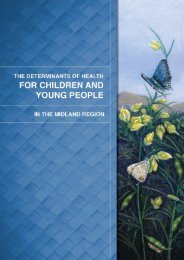Project SPLICE - Taranaki District Health Board
Project SPLICE - Taranaki District Health Board
Project SPLICE - Taranaki District Health Board
You also want an ePaper? Increase the reach of your titles
YUMPU automatically turns print PDFs into web optimized ePapers that Google loves.
<strong>Project</strong> <strong>SPLICE</strong> FINAL - February 2010<br />
A1.3.6 Home support average hours per client for Māori and All Clients<br />
8.0<br />
Average hours: All clients and Maori<br />
7.0<br />
6.0<br />
Average hours per week (estimated)<br />
5.0<br />
4.0<br />
3.0<br />
y = -0.0313x + 5.5646<br />
Av PC per week<br />
Av HM per week<br />
Av PC per week - Maori<br />
Av HM per week - Maori<br />
Linear (Av PC per week - Maori)<br />
Linear (Av HM per week - Maori)<br />
2.0<br />
y = 0.0003x + 2.1816<br />
1.0<br />
0.0<br />
Jul-2006<br />
Aug-2006<br />
Sep-2006<br />
Oct-2006<br />
Nov-2006<br />
Dec-2006<br />
Jan-2007<br />
Feb-2007<br />
Mar-2007<br />
Apr-2007<br />
May-2007<br />
Jun-2007<br />
Jul-2007<br />
Aug-2007<br />
Sep-2007<br />
Oct-2007<br />
Nov-2007<br />
Dec-2007<br />
Jan-2008<br />
Feb-2008<br />
Mar-2008<br />
Apr-2008<br />
May-2008<br />
Jun-2008<br />
Jul-2008<br />
Aug-2008<br />
Sep-2008<br />
Oct-2008<br />
Nov-2008<br />
Dec-2008<br />
Jan-2009<br />
Feb-2009<br />
Mar-2009<br />
Apr-2009<br />
May-2009<br />
Jun-2009<br />
There is a very significant drop off in average utilisation of personal care by Māori clients.<br />
Average hours per client per week for Māori are consistent with levels that would be<br />
expected in other DHBs. They are however substantially higher than the allocations for non<br />
Māori. The gap is however closing as average utilisation for Māori is dropping faster than<br />
non Māori.<br />
A1.3.7 Comparison to other areas<br />
In comparison to work that has been undertaken for other DHBs, <strong>Taranaki</strong> DHB shows a high<br />
number of household management clients and hours per capita standardised by either 65 or<br />
85 plus populations. The average utilisation per client is however toward the lower end of<br />
comparisons<br />
The number of personal care clients is also toward the higher end of comparisons but the<br />
number of personal care hours is significantly lower. This reflects a significantly lower<br />
average utilisation per client. Typically average personal care hours are around five hours<br />
per client per week. Average hours in <strong>Taranaki</strong> are only 2.6 per client per week and are<br />
declining as demonstrated earlier.<br />
This picture suggests that there has been a level of access to home based support that is<br />
consistent with national trends however this has been provided to a wider base of people<br />
and those with more complex needs have received less support. These trends are almost<br />
certainly driven as a result of allocation behaviour by needs assessors. Availability of home<br />
based support is at consistent levels with other parts of the country and is not an issue in<br />
current employment conditions<br />
46 | P a g e

















